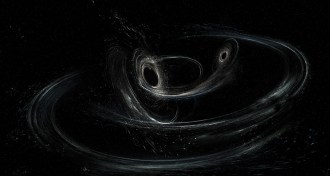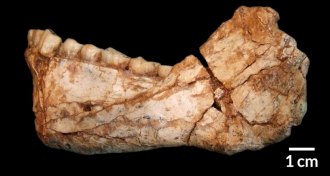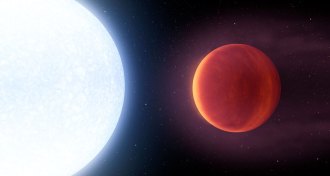Uncategorized
-
 Physics
PhysicsSwift kick from a supernova could knock a black hole askew
An exploding star may have tilted the spin of one of LIGO’s black holes.
-
 Paleontology
PaleontologyPrimitive whales had mediocre hearing
Fossils suggest that early whale hearing was run-of-the-mill, along the same line as that of land mammals.
-
 Climate
ClimateClimate change might help pests resist corn’s genetic weapon
Rising temperatures may allow pests to eat corn that is genetically modified to produce an insect-killing toxin.
By Susan Milius -
 Humans
HumansFor humans, the appeal of looking at faces starts before birth
New research suggests that 8-month-old fetuses, like newborns, are particularly interested in looking at faces.
-
 Cosmology
CosmologyMilky Way’s loner status is upheld
Galaxy surveys show the Milky Way lives in a vast cosmic void, which could help ease tensions between ways of measuring how fast the universe is expanding.
-
 Anthropology
AnthropologyOldest known Homo sapiens fossils come from northern Africa, studies claim
Moroccan fossils proposed as oldest known H. sapiens, from around 300,000 years ago.
By Bruce Bower -
 Astronomy
AstronomyEinstein’s light-bending by single far-off star detected
A measurement so precise Einstein thought it couldn't be done has demonstrated his most famous theory on a star outside the solar system for the first time.
-
 Health & Medicine
Health & MedicineChoosing white or whole-grain bread may depend on what lives in your gut
Gut microbes determine how people’s blood sugar levels respond to breads.
-
 Animals
AnimalsBig slimy lips are the secret to this fish’s coral diet
A new imaging study reveals how tubelip wrasses manage to munch on stinging corals.
-
 Astronomy
AstronomyScalding hot gas giant breaks heat records
KELT 9b’s sun blasts it with so much radiation that the planet’s dayside is hotter than most stars and its atmosphere is being stripped away.
-
 Life
LifeWhen it comes to the flu, the nose has a long memory
Mice noses have specialty immune cells with long memories.
-
 Health & Medicine
Health & MedicineWhen preventing HIV, bacteria in the vagina matter
Vaginal bacteria affect how well microbicide gels used to prevent HIV work.